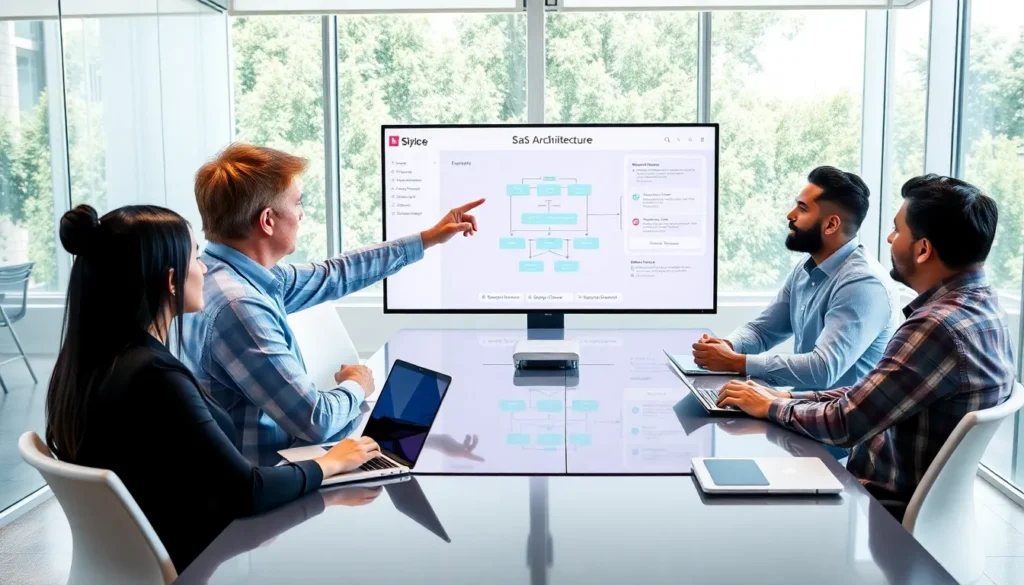Table of Contents
ToggleIn the ever-evolving tech landscape, SaaS architecture stands out like a unicorn at a dog show. It’s the backbone of countless applications that promise to make life easier, and let’s be honest, who doesn’t want a little less chaos in their daily grind? With its ability to deliver software over the internet, it’s like having a magic toolbox that’s always at your fingertips—no heavy lifting required.
But what exactly goes into this architectural marvel? Understanding SaaS architecture isn’t just for the tech-savvy; it’s for anyone who wants to leverage the power of cloud computing. From scalability to security, the right architecture can transform a simple idea into a thriving business. So buckle up as we dive into the essentials of SaaS architecture, where innovation meets efficiency, and discover how it can elevate your digital experience.
Overview of SaaS Architecture
SaaS architecture serves as a framework for delivering software applications over the internet. This model allows users to access software via a subscription rather than traditional purchase. Understanding its structure reveals how applications remain flexible and scalable.
Core components of SaaS architecture include multi-tenancy and cloud infrastructure. Multi-tenancy enables multiple users to share software applications while maintaining security and data privacy. Cloud infrastructure, delivered by a trusted cloud computing in Los Angeles, enables scalable and secure cloud environments, ensuring high availability, seamless performance, and efficient resource management for modern businesses.
Security remains a top priority in SaaS architecture. Providers implement measures such as encryption and regular updates to protect user data. Compliance with standards like GDPR and HIPAA reinforces trust among users.
Scalability represents another critical feature of SaaS architecture. Businesses can easily adjust resources according to demand without extensive investment in hardware. This flexibility supports growth and innovation, allowing companies to adapt to market changes.
Microservices architecture increasingly influences SaaS design. This approach breaks applications into smaller, independent services, facilitating rapid updates and continuous delivery. As a result, developers can deploy new features and fixes without disrupting the overall application.
Integration capabilities also play a vital role in SaaS architecture. Seamless connection with other software and systems enhances efficiency. APIs allow different applications to communicate effectively, creating a more cohesive experience for users.
Understanding these elements equips businesses with the knowledge to harness SaaS architecture effectively. Leveraging its advantages can lead to improved operational efficiency and customer satisfaction.
Key Components of SaaS Architecture

SaaS architecture consists of several integral components, including frontend development, backend development, and database management. Each component plays a significant role in ensuring the software operates efficiently and effectively.
Frontend Development
Frontend development emphasizes user interface (UI) and user experience (UX). Essential technologies, such as HTML, CSS, and JavaScript, help create responsive designs. Developers focus on ensuring applications are mobile-friendly and accessible across different devices. Visual consistency enhances user satisfaction, encouraging continued usage. Testing tools like Selenium and Jest help maintain performance. User feedback often informs iterative improvements, refining overall usability. Furthermore, frameworks like React or Angular streamline the development process, providing reusable components.
Backend Development
Backend development manages server-side interactions and processes. This area employs programming languages like Python, Ruby, or Node.js to create logic and functionality. Well-structured APIs facilitate communication between the frontend and various services. Application servers handle incoming requests, ensuring rapid responses. Scalability is often achieved through cloud services, allowing resources to adjust according to demand. Security measures protect data during transmission. Continuous integration and deployment practices improve development efficiency, allowing teams to release updates swiftly.
Database Management
Database management ensures data storage and retrieval processes are efficient. Databases, such as MySQL, MongoDB, or PostgreSQL, provide structured systems for managing user data. Data integrity and consistency are prioritized to maintain user trust. Efficient indexing and query optimization enhance performance, resulting in faster access times. Regular backups and recovery processes safeguard against data loss. Monitoring tools aid in performance assessments, identifying bottlenecks before they impact users. Techniques like data encryption protect sensitive information, ensuring compliance with standards like GDPR and HIPAA.
Benefits of SaaS Architecture
SaaS architecture offers numerous advantages that can significantly impact businesses and users alike. Understanding these benefits helps organizations make informed decisions about adopting this model.
Cost Efficiency
Utilizing SaaS architecture reduces overhead costs associated with traditional software. Subscription models eliminate the need for hefty upfront investments in licenses, hardware, and maintenance. Businesses pay only for what they use, allowing better budgeting and financial planning. Moreover, as resources are hosted in the cloud, companies save on infrastructure and IT staff expenses. This model enables startups and small businesses to access advanced capabilities without straining their finances.
Scalability
SaaS architecture provides remarkable scalability options tailored to business needs. Companies can easily adjust their subscription levels depending on user demand. Growth or downsizing happens seamlessly without significant hardware or infrastructure changes. This flexibility ensures that businesses accommodate fluctuating market demands efficiently. Seasonal promotions or new product launches become less daunting when resources can be ramped up quickly.
Accessibility
Accessing SaaS applications occurs from any location with internet connectivity. This inherent flexibility boosts productivity as employees can work remotely or on-the-go. Updates and maintenance happen in real-time, meaning users always work with the latest features. Data accessibility across devices enhances collaboration among teams. Cloud-based storage ensures that project files stay organized and available whenever needed.
Challenges and Considerations
SaaS architecture presents unique challenges that organizations must navigate for optimal effectiveness.
Security Concerns
Security remains a significant challenge in SaaS architecture. Data breaches can result in severe financial and reputational damage. Organizations must implement robust security measures, including strong encryption practices and regular security audits, to protect sensitive information. Compliance with regulations, like GDPR and HIPAA, adds another layer of complexity. On top of this, the architecture’s multi-tenancy nature can increase vulnerability points. Each tenant sharing resources means ensuring isolation to prevent unauthorized access. Therefore, prioritizing a comprehensive security strategy is crucial in maintaining user trust and safeguarding data.
Performance Issues
Performance challenges can impact the user experience in SaaS applications. Users expect fast response times and reliable service availability. Resource allocation becomes critical as companies scale operations. High traffic loads can strain servers, slowing down operations and affecting productivity. Organizations must monitor performance metrics closely to identify bottlenecks. Load balancing techniques can distribute traffic evenly, improving response times. Meanwhile, regular performance testing helps pinpoint issues early. Focusing on these aspects ensures a smooth, efficient user experience, directly influencing customer satisfaction and retention.
Future Trends in SaaS Architecture
Emerging trends are shaping the future of SaaS architecture, emphasizing enhanced security and resilience. Artificial intelligence (AI) integration stands out, providing businesses with automated insights and improved service efficiencies. Enhanced data analytics allows organizations to tap into real-time user behavior, informing better strategic decisions.
Serverless computing gains popularity, offering flexibility and reducing infrastructure management burdens. This paradigm allows developers to focus on code instead of server maintenance, streamlining deployment processes. Multi-cloud strategies are becoming prevalent as businesses seek to avoid vendor lock-in, enabling seamless operations across various cloud service providers.
The rise of low-code and no-code platforms transforms the development landscape, empowering non-technical users to create applications faster. Collaboration tools are increasingly integrated into SaaS solutions, fostering teamwork regardless of location. Mobile-first design principles continue to drive innovation, with applications optimized for mobile devices becoming crucial for user engagement.
Compliance automation integrates seamlessly into SaaS offerings. Businesses can manage their legal obligations more efficiently, reducing the risk of non-compliance issues. Efforts to enhance user privacy and data protection are paramount, aligning with evolving regulations and consumer expectations.
Finally, the emphasis on sustainability in technology cannot be ignored. Organizations prioritize eco-friendly practices within their SaaS infrastructures, minimizing energy consumption and lowering their carbon footprints. These trends highlight a dynamic landscape in SaaS architecture that continuously evolves, adapting to technological advancements and market demands.
SaaS architecture represents a transformative approach in the tech world. Its ability to deliver software efficiently and securely over the internet empowers businesses to innovate and adapt. By leveraging its key components like multi-tenancy and cloud infrastructure, organizations can enhance user satisfaction while maintaining cost efficiency.
As the landscape of SaaS continues to evolve, staying informed about emerging trends is essential. Embracing advancements like AI integration and serverless computing can provide businesses with a competitive edge. Prioritizing security and compliance will further ensure user trust and satisfaction. Ultimately, understanding and implementing SaaS architecture is crucial for any business aiming to thrive in today’s digital environment.




